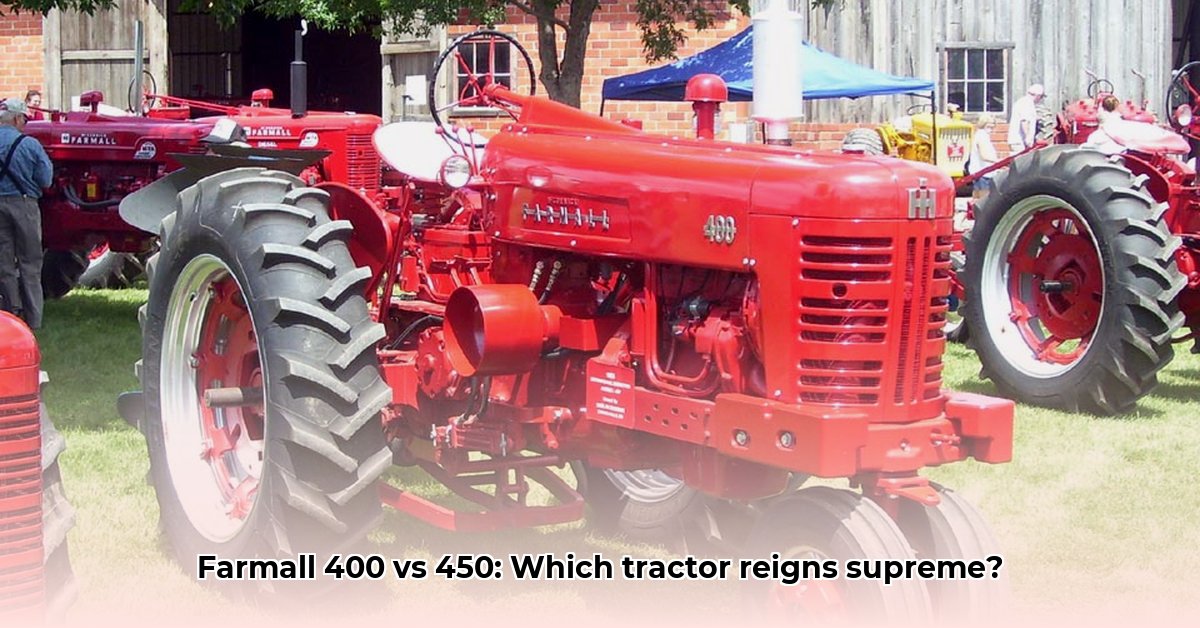
Choosing between a vintage Farmall 400 and 450 can be a daunting task. Both models represent iconic workhorses of the agricultural past, but subtle yet significant differences exist. This comparison analyzes key features, performance characteristics, and potential ownership challenges to help you make an informed decision, whether you're a seasoned collector or a prospective farmer. We'll delve into engine specifications, power output metrics, hitch systems, and more, providing a balanced assessment of each model's strengths and weaknesses. For more horsepower comparisons, see this helpful resource on tractor horsepower.
Under the Hood: Engine and Performance Discrepancies
The most apparent difference lies in engine displacement. The Farmall 450 boasts a larger engine—281 cubic inches compared to the 400's 264 cubic inches. This increased displacement generally translates to higher horsepower in the 450. How much higher? Precise quantification is challenging due to inconsistencies in older testing data. Factors such as tire condition, operator skill, and even ambient temperature can significantly influence performance readings. Consider the analogy of two similar cars with different tires; one might accelerate faster despite minimal engine power differences on paper. Similarly, available data suggests the 450 can pull heavier loads (approximately 7318 lbs compared to the 400's 6508 lbs), but these figures represent estimates from historical tests.
But shouldn't we expect significantly more power from that extra cubic inch? This is a natural question, and the answer is nuanced. The effects of the additional displacement are seen more in pulling power than raw horsepower.
Fuel efficiency presents another area of uncertainty. Preliminary reports suggest the 450 may exhibit lower fuel economy, but this conclusion relies on limited and potentially conflicting data. Fuel consumption likely varies significantly based on operating conditions, tractor maintenance, and the operator's driving style.
Camshaft Variations and Their Elusive Impact
Both the 400 and the 450 initially utilized the same camshaft (#48196-DA). However, later production runs of the 450 incorporated a different camshaft (#48196-DB). While this change probably altered performance characteristics, the exact extent of that impact remains a subject of debate among enthusiasts. The difficulty stems from a scarcity of comprehensive testing and documentation from the era. This lack of detailed information highlights a common challenge in comparing vintage machinery. Minor production variations can significantly influence a machine's behavior and make precise comparisons difficult.
Steering, Hitch Systems, and Operational Nuances
Both tractors feature power steering, improving maneuverability over earlier models. However, the condition and wear of individual units will drastically affect steering response. Both also employed a fast hitch system for quick implement attachment and detachment. A key distinction: the 450 integrated traction control into its fast hitch, potentially offering a mechanical advantage, especially when handling heavy loads. The practical significance of this difference depends entirely on the intended workload. For lighter agricultural tasks, the impact might be negligible; heavier tasks, however, may benefit noticeably from the increased traction.
Visual Identification: A Cautionary Note
A significant hurdle: some Farmall 400s have been repainted to mimic the appearance of 450s. Therefore, visual identification alone is unreliable. Always verify the tractor's identity using mechanical specifications, such as the engine serial number and model number found on the engine block. Don't let paint fool you; mechanical verification is paramount.
Comparative Overview: Key Feature Differences
| Feature | Farmall 400 | Farmall 450 | Notes |
|---|---|---|---|
| Engine Displacement | 264 cubic inches | 281 cubic inches | Larger engine suggests greater pulling power |
| Pulling Power (Est.) | ~6508 lbs | ~7318 lbs | Based on historical, inconsistent testing data |
| Camshaft | #48196-DA (and later variations) | #48196-DA, #48196-DB (and later variations) | Impact of different camshafts is undetermined |
| Fast Hitch | Standard | With Traction Control | Traction control enhances performance in heavy work |
| Fuel Efficiency | Potentially better | Potentially worse | More research is needed for conclusive evidence |
Weighing the Pros and Cons: Collector vs. Farmer Considerations
For Collectors: Authenticity is paramount. Meticulously verify the tractor's mechanical specifications and build date. Pay close attention to camshaft variations in the 450 model and look for evidence of any modifications. Original condition is key.
For Farmers: Assess the tractor's suitability for your specific tasks. Consider parts availability, potential repair costs, and overall condition. The 450's traction control could prove valuable for heavy-duty applications. Be prepared for potential challenges in sourcing parts due to their age.
Risk Assessment: Potential Ownership Challenges
| Risk Factor | Farmall 400 | Farmall 450 | Mitigation Strategy |
|---|---|---|---|
| Parts Availability | Moderate | Moderate | Network with other owners and salvage yards. |
| Mechanical Complexity | Low | Low | Regular maintenance and a good repair manual are essential. |
| Restoration Cost | Moderate | Moderate | Prioritize critical repairs. |
| Fuel Efficiency | Potentially better | Potentially worse | Budget for potential fuel costs. |
Conclusion: This comparison utilizes the best available information. However, some uncertainties remain. Further research, consultation with other owners, and careful consideration of your specific needs are crucial before making a final decision. The optimal choice depends entirely on individual requirements and priorities.